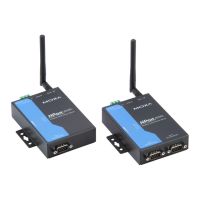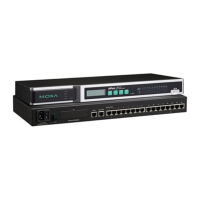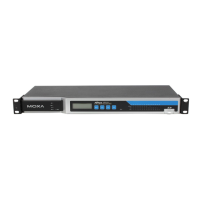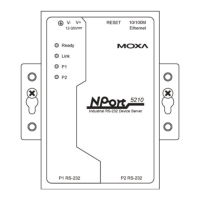NPort W2150/2250 Plus Series User’s Manual Web Console: Network Settings
6-15
Authentication
Default
Open System
Options
Open System, Shared Key, WPA, WPA-PSK, WPA2, WPA2-PSK
Description
This field specifies how wireless devices will be authenticated. Only
authenticated devices will be allowed to communicate with the NPort. If a
RADIUS server is used, this setting must match the setting on the RADIUS
server.
Open System: The NPort will simply announce a desire to associate with
another station or access point. No authentication is required. For Ad-hoc Mode,
this is the only option for authentication, since Ad-hoc Mode was designed for
open communication.
Shared Key: This option is only available in Infrastructure Mode.
Authentication involves a more rigorous exchange of frames to ensure that the
requesting station is authentic. WEP encryption is required.
WPA: This is a managed authentication option that is only available in
Infrastructure Mode. WPA was created by the Wi-Fi Alliance, the industry trade
group that owns the Wi-Fi trademark and certifies devices with the Wi-Fi name.
It is based on Draft 3 of the IEEE 802.11i standard. Each user uses a unique key
for authentication, distributed from an IEEE 802.1X authentication server, also
known as a RADIUS server. This option is also referred to as WPA Enterprise
Mode, since it is intended to meet rigorous enterprise security requirements.
Tunneled authentication is supported, depending on the EAP method selected.
WPA-PSK: This is an unmanaged authentication option that is only available in
Infrastructure Mode. Instead of a unique key for each user, a pre-shared key
(PSK) is manually entered on the access point to generate an encryption key
that is shared among all users. Consequently, this method does not scale well
for enterprise. A PSK that uses a mix of letters, numbers and non-alphanumeric
characters is recommended. This option is also referred to as WPA Personal
Mode, since it is designed for the needs and capabilities of small home and
office WLANs.
WPA2: This is a managed authentication option that is only available in
Infrastructure Mode. WPA2 implements the mandatory elements of 802.11i.
Supported encryption algorithms include TKIP, Michael, and AES-based
CCMP, which is considered fully secure. Since March 13, 2006, WPA2 has
been mandatory for all Wi-Fi-certified devices. This option may also be referred
to as WPA Enterprise Mode. Tunneled authentication is supported, depending
on the EAP method selected.
WPA2-PSK: This is an unmanaged authentication option that is only available
in Infrastructure Mode. It employs WP2 encryption algorithms but relies on a
PSK for authentication. A PSK that uses a mix of letters, numbers and non-
alphanumeric characters is recommended. This option can also be referred to as
WPA Personal Mode.

